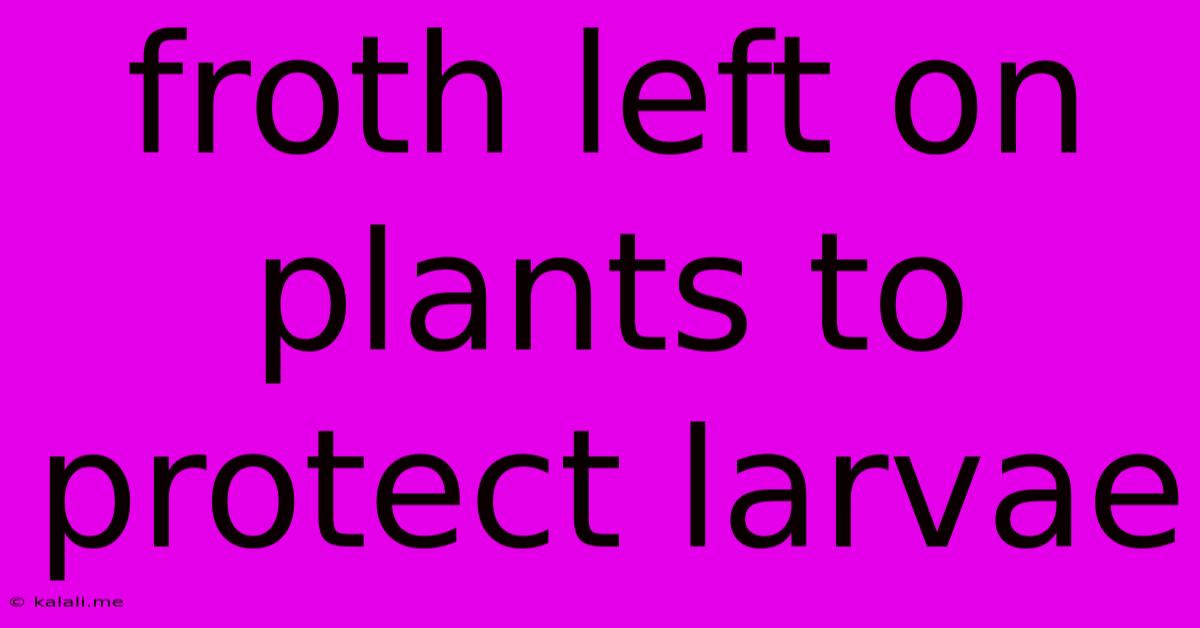Froth Left On Plants To Protect Larvae
Kalali
May 21, 2025 · 3 min read

Table of Contents
Froth on Plants: A Protective Haven for Insect Larvae
Have you ever noticed a curious, bubbly froth clinging to the stems and leaves of plants? This isn't some strange plant disease, but rather a clever protective strategy employed by certain insects to safeguard their young. This article delves into the fascinating world of insect froth, explaining its purpose, the insects that create it, and the role it plays in the delicate balance of the ecosystem.
What is this froth and why is it there? The frothy substance, often referred to as "cuckoo spit" or "spittlebug foam," is created by the nymphs (immature stage) of various insect species, primarily belonging to the family Cercopidae (spittlebugs) and Aphrophoridae (froghoppers). These tiny creatures produce the froth as a protective shelter, shielding them from predators, parasites, and the elements. The foam's structure provides excellent insulation, maintaining a stable temperature and humidity for the developing nymph.
The Composition of the Protective Froth:
The froth itself is a remarkable mixture:
- Secretions: The nymph excretes a sugary liquid from its anus.
- Air Bubbles: The nymph incorporates air bubbles into the secretion through rhythmic movements of its abdomen.
- Plant Sap: The liquid is mixed with plant sap, contributing to the froth's overall consistency.
This unique blend creates a protective barrier that is surprisingly effective. The froth is not only a physical shield but also helps camouflage the nymph, making it difficult for predators to spot.
The Insects Behind the Froth:
Several insect families are known for their froth-producing nymphs:
- Spittlebugs (Cercopidae): These insects are commonly found on various plants, including grasses, shrubs, and even some trees. Their froth is typically white or grayish.
- Froghoppers (Aphrophoridae): Froghoppers are often found on herbaceous plants. Their froth can vary in color, sometimes appearing slightly yellowish or brownish.
- Other Hemiptera: While less common, other Hemiptera species also create froth to protect their young.
Identifying the specific insect based solely on the froth can be challenging, as the appearance can vary depending on the species and environmental factors.
Ecological Significance:
While the froth might seem inconsequential, it plays an important role within the ecosystem:
- Predator Avoidance: The froth serves as a highly effective defense mechanism, significantly reducing predation rates.
- Environmental Protection: It provides insulation against temperature fluctuations and helps maintain a humid microclimate.
- Food Source: While the froth itself isn't a primary food source, the insects that produce it are part of the food web, serving as prey for various predators, including birds and other insects.
Should You Worry about Froth on Your Plants?
Generally, the amount of damage caused by spittlebugs and froghoppers is minimal. While they feed on plant sap, the damage is rarely significant enough to warrant intervention, especially on healthy, established plants. In most cases, the froth is a harmless natural occurrence and does not require any treatment. However, in cases of severe infestation, you might consider using a strong jet of water to dislodge the nymphs or employing organic pest control methods.
In conclusion, the seemingly innocuous froth found on plants is a testament to the ingenious survival strategies of insects. It's a reminder of the intricate and fascinating relationships that exist within the natural world, highlighting the importance of understanding and appreciating even the smallest inhabitants of our ecosystems.
Latest Posts
Latest Posts
-
What Electrical Plugs Are Used In Ireland
May 21, 2025
-
How To Get Rid Of Diesel Fuel Smell
May 21, 2025
-
Lion Turtle Avatar The Last Airbender
May 21, 2025
-
Knocking Noise When Turning Steering Wheel
May 21, 2025
-
What Size Waste Pipe For Sink
May 21, 2025
Related Post
Thank you for visiting our website which covers about Froth Left On Plants To Protect Larvae . We hope the information provided has been useful to you. Feel free to contact us if you have any questions or need further assistance. See you next time and don't miss to bookmark.